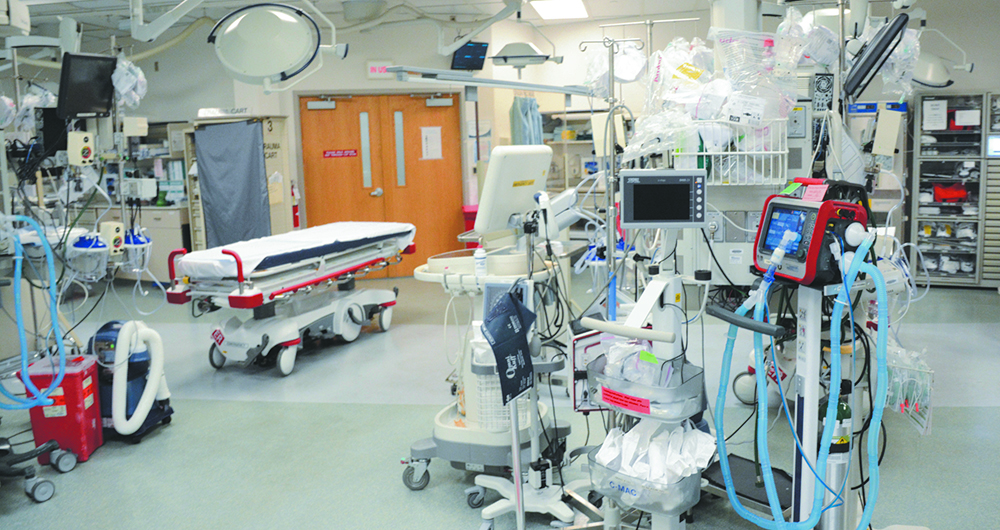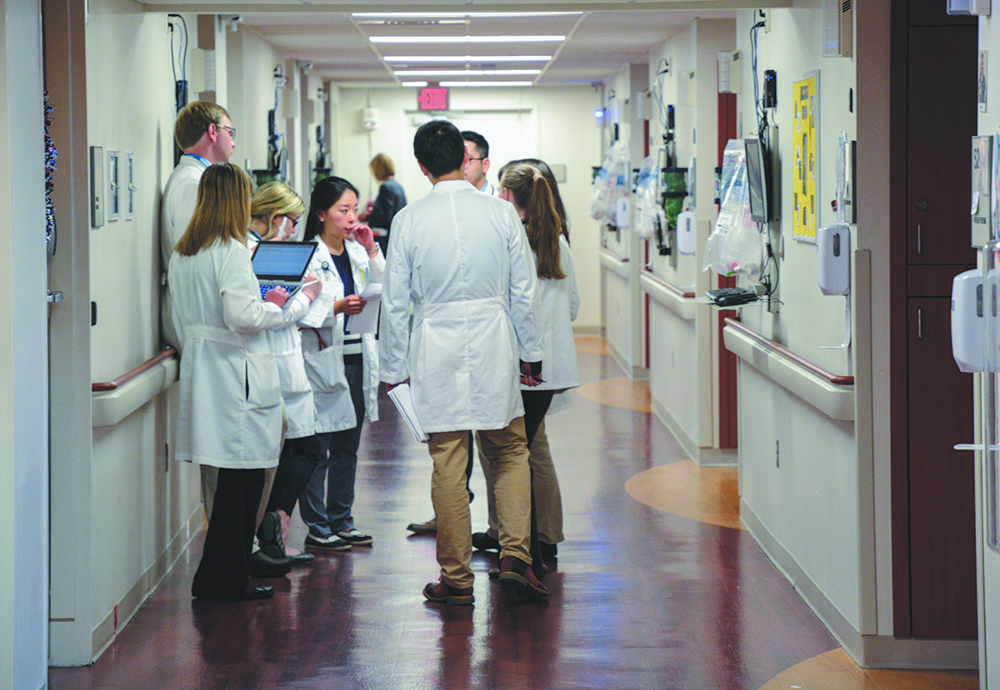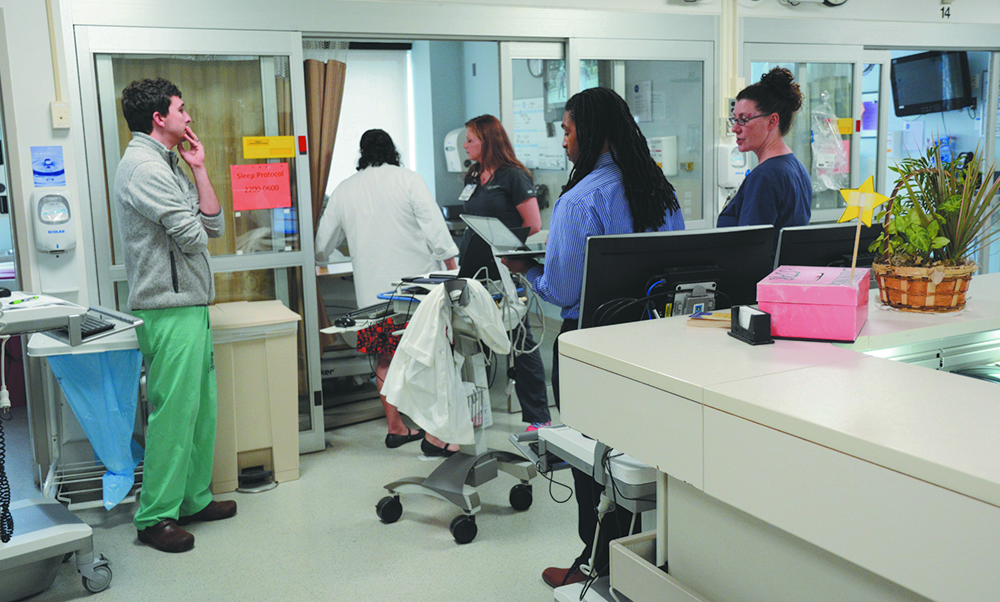Trauma situations are about moving from one phase to another.
From the gurney to the table.
From the table to X-ray.
From X-ray to surgery.
From surgery to intensive care.
From ICU to another inpatient room.
And from there, it can mean a whole host of recovery possibilities.
The trauma unit at Geisinger Medical Center in Danville continues to move forward with more efforts to care for life-versus-death situations, just as it has since its accreditation in 1985.
The latest move includes the newly designated trauma intensive care unit that is planned to be unveiled in mid-July.
An entire floor of the hospital is now designed to accommodate trauma patients only following their initial visit into the trauma bay.
“We were rounding 11 different places in the past,” said Denise Torres, trauma medical director at Geisinger Medical Center.
Torres recently gave The Daily Item an exclusive look inside the trauma unit process, starting from the moment a patient comes through the back doors with emergency medical services personnel.

Initial exam
Fifteen medical professionals, robed and masked, are waiting per patient when that call from dispatch comes in. Roles include nurses, physicians, resident physicians, attendants, surgical staff, chaplains, CAT scan and X-ray technicians and pharmacists. Torres said the initial appearance of this many people when one enters the room may be a bit daunting to the patient.
Geisinger is a level one trauma unit, which means it must be prepared for the worst of the worst scenarios in medical emergency, treating situations from within a 100-miles radius, serving 42 counties in the state.
Most hospitals in the area send their critically injured to Danville.
“We are it,” Torres said, which is something the staff takes seriously.
“We have three bays so that we can have three patients here at the same time,” she said, which means 45 or more professionals may be on hand at one particular moment in the room which typically has an indoor temperature of 80 degrees.
“We keep it hot like this because patients who are injured get cold fast,” Torres said, adding heated blankets are applied to the patient, too.
When a patient comes into the bay, a verbal report is given of the person’s gender, age, what happened to the individual and what the known injuries are. Patients are completely disrobed. Any and all clothing is cut from the body.
“All of the monitors are going,” Torres said as she pointed out the various screens in the bay area.
“We have a refrigerator with blood in it ready to go,” she said. There is a door in the unit that goes directly to CAT scan so that internal images can give a clear perspective on all that is happening with the patient.
While the hands-on treatment is taking place, an individual is on hand recording every finding that is called out by physicians. This is for the Advanced Trauma Life Support file or the ATLS.

Clean and repeat
Torres said typically eight trauma cases come through the doors in a 24-hour period. One night recently, she said, between the hours of 5:30 p.m. and 2 a.m. 10 patients were treated.
As that first emergency care is provided and the patient is shipped out to surgery, an environmental clean-up team comes into the bay to remove the scene of blood, paper and all that is strewn around the room in the chaotic moments of care.
“There is a lot of trash on the floor. It is a bloody mess most of the time,” said Torres. “We rely heavily on the (clean-up) team.”
Through an additional set of doors is the elevator to the operating room, which may be put on hold with staff waiting for the expected trauma patients.
Entering intensive care
Upon leaving surgeries, many patients are sent to the Intensive Care unit, ICU, and soon the new Trauma Intensive Care Unit or TICU will be their destination.
This part of trauma is comprised of doctors, pharmacists, physical therapists and nurses.
Dr. Susan Baro, trauma surgeon at Geisinger, is the director of the new unit. Baro has served 17 years at the hospital and is excited for the trauma patients to have their own location.
“We have waited a long time for this,” she said, “This gives us an opportunity to have specialty care. This allows us to focus all of our expertise at one time on these needs. We are able to be a more constant presence for patients and we are able to do it in an isolated unit.”
Baro said all trauma patients at Geisinger have been given the best possible care over the years, “And this just ups the ante,” she said.
Colby Faust is the RN Manager of the new 14-patient room unit which he described as “brighter.”

Virtual nurses
An innovative part of the TICU is the addition of EICU, or electronic intensive care unit.
Cameras are in each room with video monitoring. Critical Care Registered Nurses or CCRNs, can keep a 24-hour watch on patients. Nurses are still on site and in and out of the patients rooms as they always have been. This is an additional service, Faust said, that provides an extra set of eyes for critical care.
The image will appear on the screen in the room and the nurse will announce he/she is observing so patients know of the CCRN’s presence.
“They can do pupil checks,” Faust said, “and they can look at the pumps,” he said, allowing the EICU nurse to report to CCRNs on the floor of any changes immediately. These virtual nurses can look up lab documentations and other pertinent information as well.
Barbara Judd is one of the EICU nurses who observes from the Geisinger Woodbine Outpatient Clinic location.
“It is really a second layer of nursing,” she said, as her image was visible on the screen in an empty patient room in the unit.
There is a physician in the program in the evenings who also looks through the cameras.
Faust said all images are live and nothing is ever recorded in order to protect patient privacy.
Half of the staff in this unit have critical care certifications, Faust said.
Surgery rooms available
Another part of the trauma care process is the med/surg unit. This includes 20 private rooms for patients who have had surgery due to traumatic injury or perhaps do not need intensive care after their incident.
Torres said the patients in these rooms are on their way home or on their way into rehabilitation units close to home. The trauma stay at Geisinger can vary, of course for each person who comes into the bay after their accident.
“Most average five days,” Torres said, “Some are here 23 hours. More severely injured could be here a week or more.”
